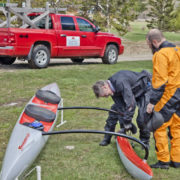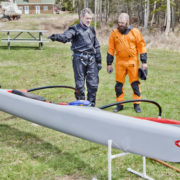The Importance Of Comfort
by Jacques Blais
Cold Water Paddling in Eastern Canada
EasternOutdoors.com
On May 3rd, this year, I went out paddling with Jimmy Perron who was visiting Robert Vlug in Dipper Harbour (Robert runs Eastern Outdoors, a kayaking tour and outfitting company). Jimmy hails from Port Cartier, Québec, and he was on his way back from a kayaking course in Nova Scotia.

If you come by Chance or Dipper, call! I’m always
looking for paddlers to go out with. (Robert’s truck in the background)
The wind on Wednesday late morning was blowing a stiff “breeze” against an ebbing tide and the combination made for challenging conditions outside of the harbour heading to Point Lepreau. I wanted Jimmy to experience paddling on a double outrigger canoe (OC-2) in rough water. While it is generally understood that the ama (the outrigger support) helps stability in rough ocean conditions, an outrigger canoe will still huli (capsize) in some wild ocean conditions, and/or simply as the result of human error! Well, huli we did! Twice!!
I had never involuntarily capsized in cold water before–only in voluntary practice situations. Therefore I had never fully appreciated the full benefit of a good dry suit: there was no cold water shock at hitting the water! While fully immersed, I was entirely comfortable in the water even with the minimum amount of layering under my suit: single layer on legs and double on top. To relieve the extra buoyancy that made it a bit awkward while bobbing in the waves, I simply “burped” the suit by letting air out from the neck’s neoprene gasket.
With both of us clearly comfortable in our predicament, there was no need to rush into rescue mode. Jimmy was a quick study: calmly following directives, he swam around the upside down canoe and helped with righting it; once I also got around to the ama side, we remounted one after the other before resuming the downwind leg of our paddle … Only to huli once again!
How long were we in the water? Neither of us timed it, nor cared; but by this second huli, we were both laughing … and commenting on the inevitability of paddlers getting wet. Bobbing in the waves was actually fun. A reminder that we’re all kids at hearth and that playing in the ocean is a blast!

Jacques lives in Chance Harbour, NB (in the black the suit),
Jimmy is from Port Cartier, QC
Once we got back up again, another reality sunk in: there was no need to rush into shore to get changed; we were dry inside our suits and we were warm! So we stayed out a while longer; and we stayed upright!
There was never any tense moments, no feelings of urgency, only the realisation that experience, competence and good equipment matter, since it all provides that all important comfort zone.
For those unfamiliar with the geography of Eastern Canada, Dipper Harbour is located along the north coast of the famous Bay of Fundy, in New Brunswick. Famous for the size of its tides! The Bay of Fundy boasts the world’s largest tides at the head of the Bay. Our big tides have the effect of churning bottom cold water up to the surface. And that explains in part the sub artic marine life found in its environment. For a paddler, what is essential to know and be prepared for is that the water is very cold. The water was 3.5 C (38.3 F) the day we went out. Throughout the year, the temperature range fluctuates from 1.8 C (35.2 F) in March and April to 12.7 C (54.8 F) when the waters are at their warmest in September.
Note: Jimmy had never been on an outrigger canoe before but as a very competent kayaker, I knew that he would be completely comfortable in the conditions we chose to paddle in. We have plans to do this again when he returns in the fall.

 Meet Gemini: OC2 canoe by Kai Wa’a
Meet Gemini: OC2 canoe by Kai Wa’a 